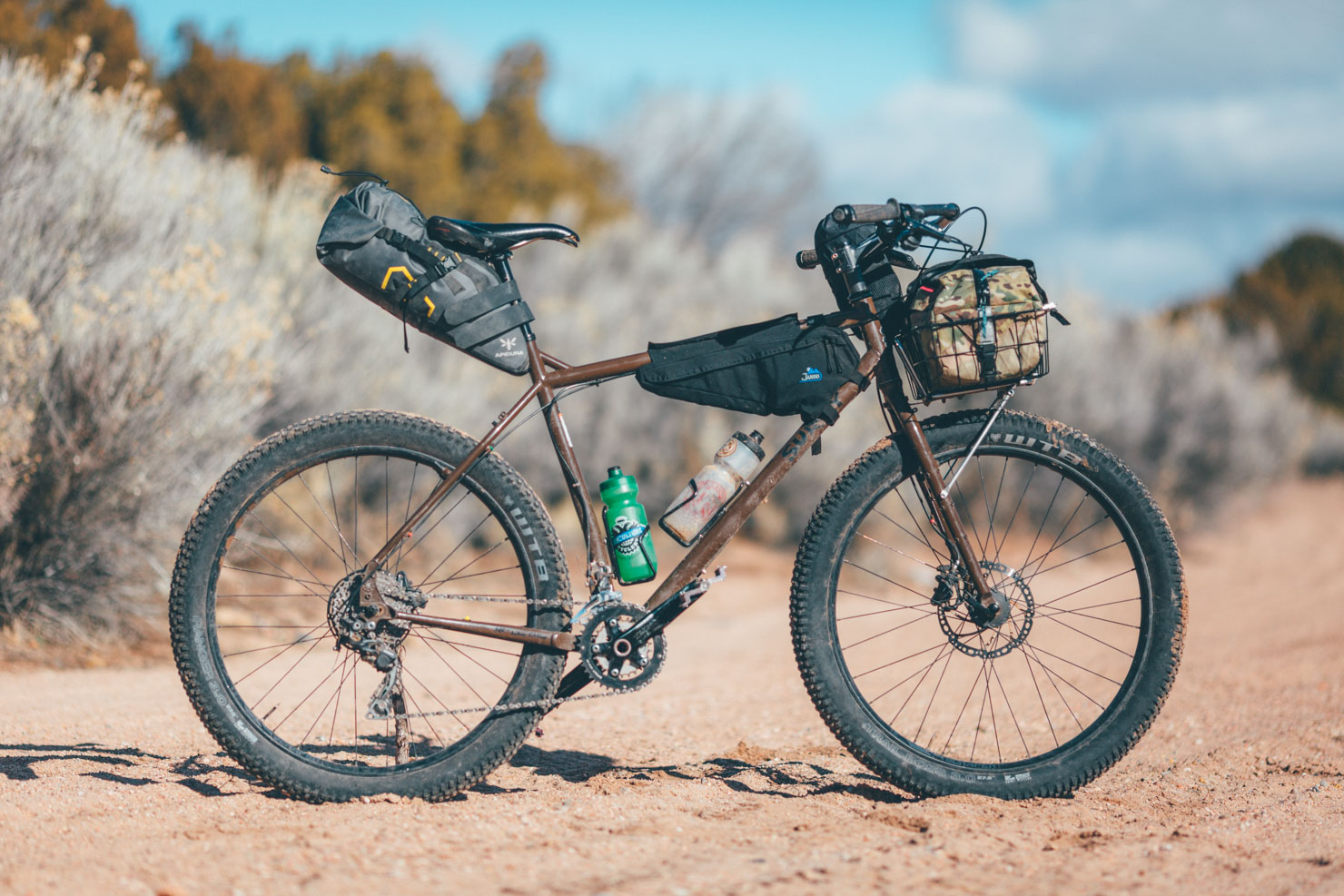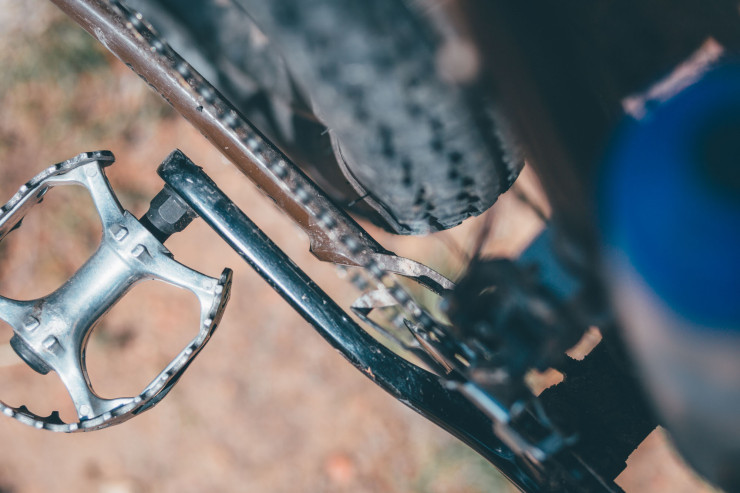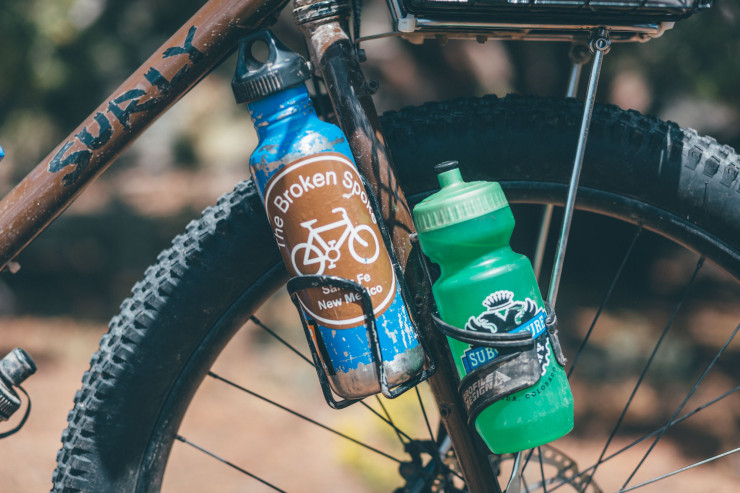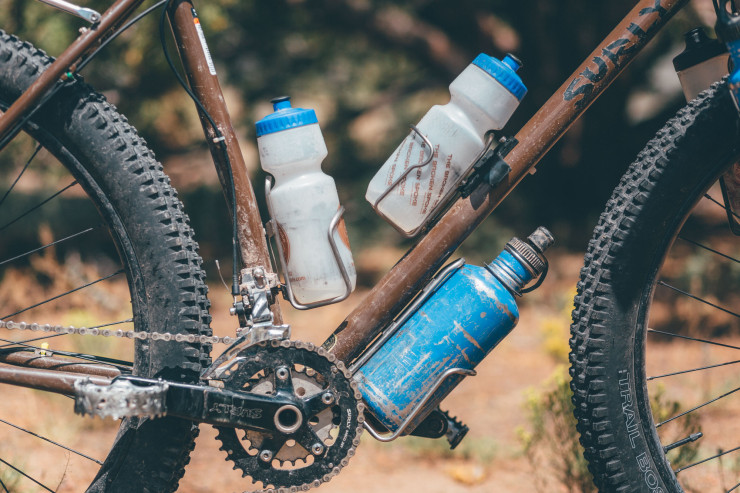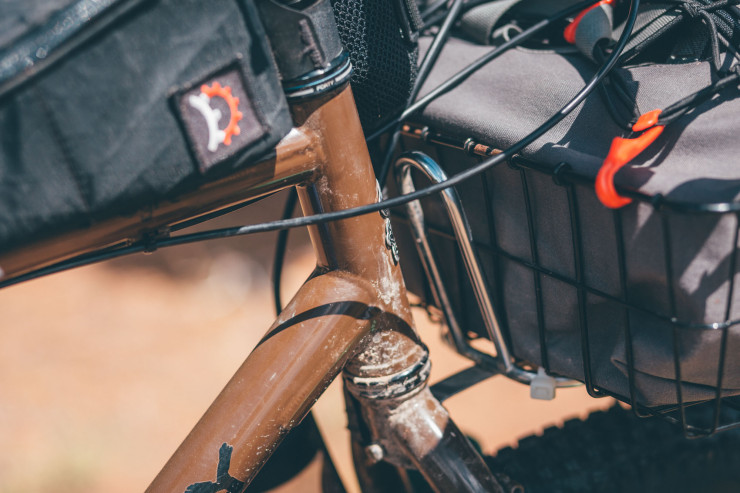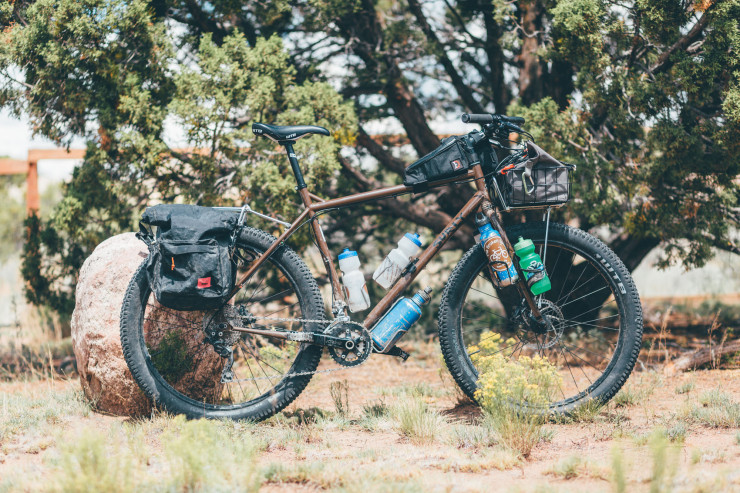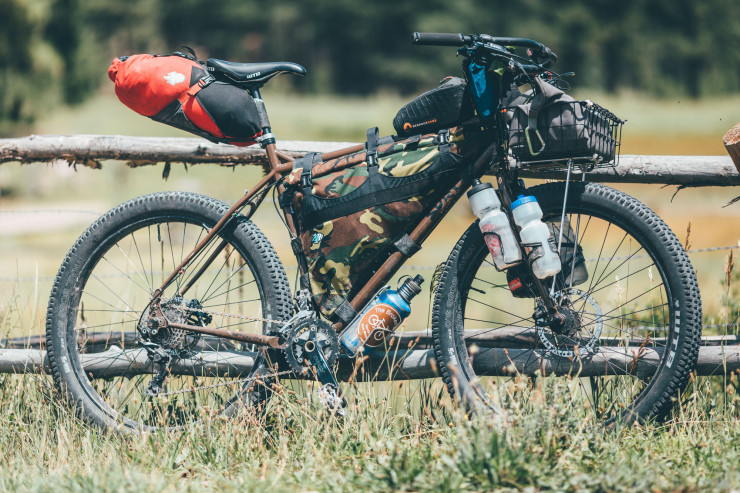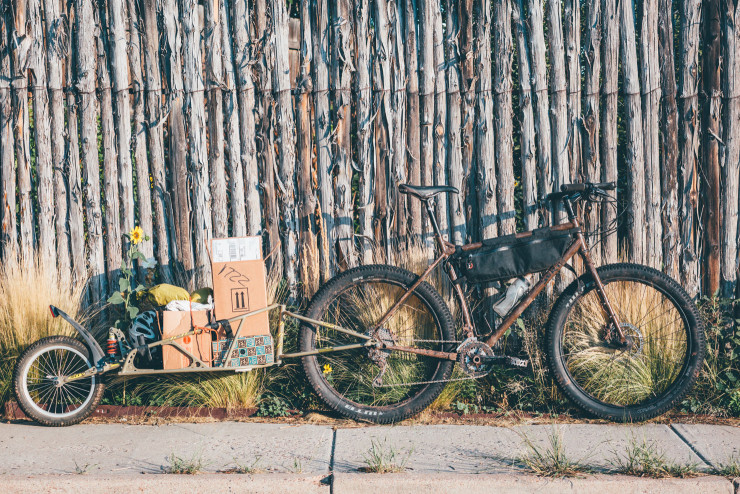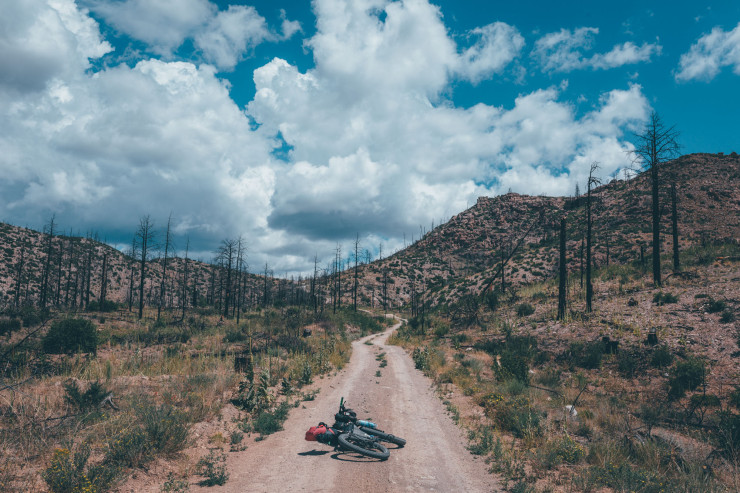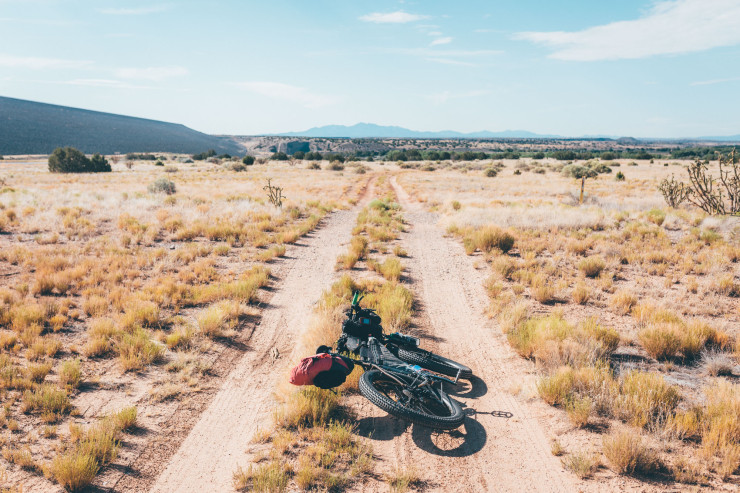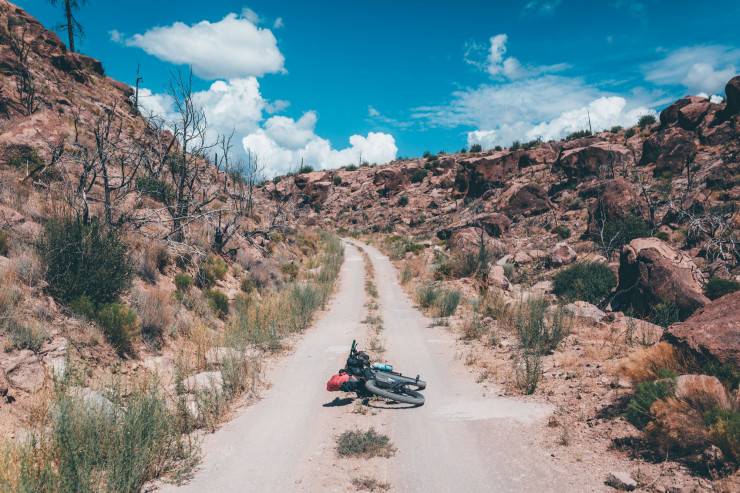2017 Surly Ogre Review: ETs, Molokos, 27.5+, and a braze-on fiesta…
Following the Troll’s recent revamp, it was only a matter of time before Surly’s 29er all-rounder, the Ogre, underwent a similar transformation. Read on to discover details of its 2017 incarnation and thoughts on its frameset, set up with 27.5+ wheels. Also included are musings on the relative merits of different Plus sizes, depending on the style of your backcountry explorations.
In case the title of this post sounds like we’re speaking in tongues… let me explain. Surly’s popular, globe-trotting Troll recently saw a significant revamp. The updated model ushered in clearances for dirt-chomping 26+ tires. Its eyelet-riddled fork added provision for Anything Cages both forward and aft. Its rear spacing introduced Surly’s new Gnot-Boost dropout, compatible with a range of hub standards, both old and new. Last but not least, the Troll’s geometry was rejigged into a rigid specific design, forgoing the option of running a suspension fork in lieu of a larger framebag.
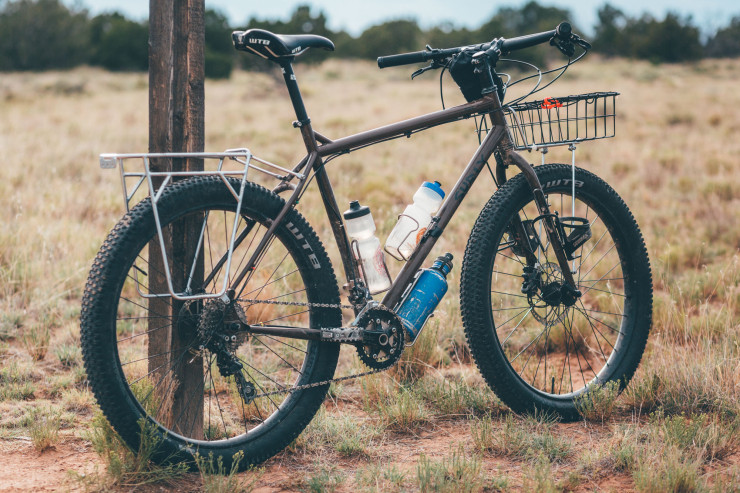
Just a few days ago, Surly announced the 2017 Ogre. It sports a similar slew of updates as the Troll, albeit with 29er wheelset that can now be swapped out for 27.5+ tires, the most popular diameter in the Plus-size fold. Surly have only released the first few details so far. Here’s our take on its changes and an account of our hands-on experience with the frameset, having used it bikepacking, commuting around town, and on local trails. We’ll add a link to a geometry table when it’s available.
First things first. Let’s talk wheels. Being a fan of the Plus size wheel format, I was delighted to see that thanks to a new yoke, the 2017 Ogre now accommodate 27.5+ tires, the wheel size that’s fast becoming the de facto norm. Clearances are on the generous side too. During my test riding, I ran both chunky, 3in WTB Trail Bosses and the slightly narrower Ranger Tough – a great touring option, incidentally – with plenty of room for mud clearance or a buckled wheel.
There are, however, a couple of caveats. For one, you’ll need to run a single chainring with a Boost crankset or (ideally) an offset double – like Surly’s OD crankset pictured here – to enable sufficient clearances between the chain and tire. The latter is definitely optimal, while a 1x crankset could still result in some chain rub in the last cog of the cassette. Specced with a standard 29 inch wheelset, the 2017 complete Ogre comes with a standard 48x36x26 Shimano LX triple, so it’s an after-market change you’ll have to make.
Given its horizontal dropouts and the lack of an eccentric bottom bracket, running 27.5+ wheels will also lower the bottom bracket height, due to their smaller outside diameter. Although the BB drop is the same on both new and old Ogres (68mm), running a 27.5+ tire will decrease its height by at least 10mm, depending on the tire you’re running – putting it at around 295-300mm mark. Although this sounds significant, the reality was that given my uses for the bike — relatively mellow desert singletrack, dirt road touring, and commuting — pedal strike didn’t prove to be the issue I was expecting. Only on the occasions when I hit rockier trails did I notice the difference. In hindsight, I’d recommend speccing 170mm cranks to make up for some of the shortfall, especially if you’re headed for chunkier terrain and ride with flat pedals.
26+x27.5+x29+?!?
Here at BIKEPACKING.com, we’re big fans of the wide rim and Plus size wheel format, whether it be 35mm rims and 2.8in tires or 40mm+ with 3in rubber. Racing aside, we believe Plus tires are a great choice for exploratory, backcountry touring, especially for those running a rigid setup. They strike a practical balance between full fat and conventional tires. They’re confidence-inspiring offroad. And whilst unable to match the breadth of terrain covered by a fat bike, they’re encourage adventures in places previously overlooked by many bicycle tourers. But there’s a question we’ve often asked: with so many wheel diameters to choose from, which is best for what? Given the ever-shifting landscape of tire widths and wheel sizes — as well as their availability both at home and abroad — here’s our thoughts…
For a world trip, particularly one that includes the African continent, there’s still advantages to running a 26in wheelset. Despite the prevalence of courier agencies, nothing beats the convenience of buying parts locally to keep you on the road – 26in remains the firm favourite of hardware stores the world over. Given the availability of WTB’s Ranger Tough in a 3in width and other options, the new Surly Troll has rekindled our interest in the 26in format. For smaller riders, 26+ wheels offer significantly more clearance between the tire and the seat post than other Plus sizes, allowing space for a larger seatpack. In the case of Surly’s range, the Troll comes in an XS size, unlike the Ogre.
29+ remains a solid choice, especially for taller riders. At 6’1″, it’s my wheel size of choice; smaller riders may run into real estate issues between tires and bags. Run as part of a rigid setup, a 3in 29+ tire is extremely capable off-road. In many ways it rules surpreme across rough terrain, thanks to its ability to roll over the largest of babyheads. Options for long distance, bikepacking-friendly tires are relatively good, including WTB’s Ranger Tough and Maxxis’ Chronicle. In larger cities at least, standard-width 29er tires are globally available, should you need a bail out option for your midfat rim.
Although smaller in diameter than a 29+, 27.5+ still takes the bite out of rocky trails, helps negotiate sandy arroyos, and adds noticeably to rider comfort, without adding excessively to a bike’s weight. Spares tires are that bit lighter to carry too. 27.5+ is a size that will likely work for those of both large and small stature, making it a good choice for couples of differing heights who want run to run compatible wheel sizes. The 27.5+ format is becoming increasingly available globally; in a worst case scenerio, a damaged wheel can be replaced with a 29in wheelset, as the outside diameter is similar. There are more suspension forks available and rear racks with suitable clearances are easier to source. For those heading overseas, a 27.5+ bike is easier to box and or cram into the underbelly of a bus than one with 29+ wheels. Given the ever-increasing range of 27.5+ tires on offer in Europe and the US, many backcountry trips may be best served by this in-betweener size.
The dropouts themselves will be familiar to anyone with experience of the Surly touring lineup. Like its predecessor, the new Ogre can be run with derailleurs or as a singlepeed, along with various cargo-pulling configurations — like a BOB trailer or Surly’s two-wheeled siblings, Bill and Ted. As with the last generation of Ogres, the dropout features a slot for anchoring a Rohloff internal hub. Whilst we applaud Surly for its trademark versatility, it does come at a cost to practicality. In terms of removing the rear wheel and tensioning the chain, it’s certainly not as user-friendly as an eccentric bottom bracket and a Rohloff-specific dropout. Also of note is an increase in the welding surface. I’ve come across a handful of riders on long, demanding trips across South America that have had cracks develop at the junction of the chainstay and older generation dropouts. Hopefully this improvement will address the issue.

As for its 12mm x 145mm Gnot Boost spacing, there are inevitable pros and cons to the system. One the one hand, it allows the use of either 12 x 142mm thru axle or 12 x 148mm Boost thru axle hubs. By using Surly 10/12 Adapter Washers, as I did, 10 x 135mm bolt on or 135mm QR hubs are compatible too, reassuring in this ever-shifting world of ‘standards’. The downside? It’s not a captive thru-axle design, so you’ll lose out on the inherent stiffness of the system. To run a 27.5+ wheel, you’ll also need to pull the wheel back 12.5mm in the dropout. Surly supplied me with a prototype Monkey Nut that helps position the wheel. It works really well and there’s been no slippage to report. For QR hubs, you’ll need to deftly hook the cassette around the chain, a task that inevitably involves oily fingers. My advice? Go tubeless, so wheel removal rarely becomes an issue. Bear in mind too that Surly recommend lowering the tire pressure so sidewalls don’t rub against the canti-studs. At this point in time – given the quality of disc brakes and the ever decreasing availability of rims with braking surfaces – I’d be happy to lose them altogether. But I’m not going to complain too vocally.
In terms of the frame itself – 4130 cromoly steel, of course – the headtube sees a small but welcome extension, in lieu of a longer, suspension compatible rear fork. As a rider who gravitates towards a fully rigid setup, especially for dirt road touring, I see this as a welcome refinement and a more clear way of differentiating the Surly lineup. The result is a bike built for purpose that features a considerably larger framebag space. The one on my XL test bike is simply enormous, on par with the Jones Plus. If a plush suspension fork is a necessity for your bikepacking adventures, the more trail-orientated Karate Monkey is likely a better fit, or there are plenty of other options on the market.

Headtube and seat tube diameters all remain the same — 1 1/8″ non-tapered and 27.2mm respectively — which means parts unearthed in your garage can likely be pressed into service. I’m glad to see Surly have kept the Ogre ‘old fashioned’. When it comes to setting up a touring or commuting bike, there’s nothing more satisfying than recycling old possessions.
Clearances are drawn for 29×2.6in tires – depending on rim choice and tire tread – assuming the ‘legal’ 6mm spacing on either side of the tire is to be maintained. In reality, there’s scope for more; we even managed to squeeze in a 3-inch Knard, albeit with a razor tight clearances at the back. Still, a 2.6in tire, like Schwalbe’s Nobby Nick, on a 35mm rim sounds like a great setup to me.
As we’ve mentioned, there are eyelets for three water bottles on the frame, complimented by a three-pack mount above and below the downtube. The fork sees provision for up to four bottles/Anything Cages though if you want to run a front rack too, there may be a conflict of interests. I tried it with a Nitto M18 and found room for 4 water bottles by using longer, replacement struts. I also fitted Surly’s excellent 8-Pack rack, which limited me to two Anything Cage mounted behind it. Running a full soft bikepacking bag setup will give you the most options. Having a fork covered in barnacles may not be to everyone’s aesthetic tastes, but it sure is practical.
Taller riders should be aware that sizing on the new Ogre has also seen a change. XL and XXL have now become meshed into one – at 640mm, the XL Ogre’s effective top tube sits squarely between the two older sizes. Seat tube length remains identical to the older generation XL. Beanstalks and Clydesdales may feel a little short-changed. Still, a generous headtube length and an upright stem should ensure even leggy riders can dial in an upright handlebar position to match their saddle height. At the other end of the scale, more petite bikepackers will need to check out the Troll, as there’s no XS frame in Ogre flavor. Elsewhere, sizing remains similar between the two generations, if just a hair longer in the effective top tube lengths.

As for the ride itself, the Ogre really won us over. A total of four riders spent varying amounts of time riding my test bike. Everyone returned with extremely positive reports. Although the new version is 1cm longer in wheelbase than the legacy frameset – and a touch longer still if running a 27.5+ wheelset – the trail figure is relatively similar between the two generations. Don’t assume that the loss of a suspension compatible frame has turned the Ogre into a staid tourer. It’s quite the opposite. Even with 27.5+ wheels, the Ogre threads through singletrack in an extremely engaging way, while its longer wheelbase adds subtly to its stability under load. Surly’s choice of frame tubing felt well suited to my demands and weight, including multi-day bikepacking, grocery shopping, and kid hauling. In the interests of one bike simplicity, I ended up leaving my Wald 137 basket attached, making it the consummate all-rounder. The 27.5+ wheelset I was running — Ranger Plus tires and Scraper — kicked up to speed nicely on pavement and kept their speed well. I’d consider it better suited to road miles than an equivalent 29+ wheelset and only a little more slovenly than a 29×2.4in tire.
Spec-wise, the Ogre’s most notable changes include its new, tubeless-friendly 2.5in ET touring tires, now available in a 29in format. Rims for the production model are a somewhat modest 25mm wide. Given the unlikelihood that I’d choose to run the Ogre with narrow slicks, I’d have far preferred a rim that lies in the 35mm internal diameter ballpark.
The new Ogre also swaps out my all time favorite handlebar, the Jones’ Loop H-Bar, for Surly’s oddball Moloko – a chromo alternative that sports a 34 degree sweep and a 735mm width, as well as two protruding horns that offer a dizzying variety of riding positions or, if need be, impaling options should the advent of the apocalypse present itself. The main observation I’d make is that the forward sweep is greater than the Jones, requiring a shorter stem. Factoring in the longer top tube on the XL I tried, this extended my reach more than I like. If you can look beyond Moloko’s freaky looks and their hefty weight, it’s an interesting option for those who favour a full gamut of hand positions and if necessary, handlebar real estate for a spectrum of electronic gizmos.
Still, whether you are a Moloko fan or not, there’s not doubt that $1700 for the complete bike makes it a compelling build. As a sidenote, I’m glad to see the inclusion of a Shimano drivetrain – if only because Shimano BBs are so much easier to source outside the US – as well as the likes of low maintenance, 10-speed Microshift shifters and my favourite BB7 brakes. There’s one caveat though. As my desire for backcountry exploration has increased and my need to ride quickly has consequently diminished, the Ogre’s 48x36x26 chainrings seem over-geared to me.
For reference, here’s the majority of the 2017 Surly Ogre complete build kit:
- Frame: SM/MD/LG/XL
- Colors: Rover Brown
- Rims: Alex Adventure 2
- Rear Hub: Shimano Deore
- Front Hub: Shimano Deore
- Tires: Surly Extra-Terrestrial 29×2.5″
- Crankset: LX 48/36/26
- Front Derailleur: Deore
- Rear Derailleur: Deore
- Bottom Bracket: XT
- Cassette: HG50 12-36
- Handlebar: Moloko 735mm 34° Sweep
- Saddle: WTB
Pros
- Non suspension corrected frame maximises framebag space.
- Fun and nimble ride.
- Easily built up with parts that lie close to hand.
- Accomodates both new and old hub standards, as well as a Rohloff.
- Riddled with eyelets on the fork and frame, for all your water carrying and rack-mounting needs.
Cons
- Rims on stock bikes are on the narrow side for running big volume tires.
- Whilst very versatile, horizontal dropouts are more fiddly to use than vertical ones.
- Running a 27.5+ wheelset lowers pedal clearance, resulting in potential pedal strikes over chunky terrain.
- 48/36/26 triple is overgeared for loaded, backcountry explorations (but good for fast touring and commuting).
- XL and XXL sizes are now one; some Clydesales may feel short changed.
- Price$1699 USD complete, $700 for the frameset
- Sizes available S, M, L, XL
- Size tested XL
- Place of Manufacture Taiwan
- Contact SurlyBikes.com
Wrap Up
Given that we’ve only tried the frameset, this isn’t a comprehensive review of the complete Ogre. But having ridden spent a considerable amount time on a bike set up with 27.5+ wheels, it’s hard not to wax lyrical about it. The new Ogre is fast and fun through singletrack. It’s extremely versatile. And it hits a very inclusive price point. All in all, it’s a very capable all-rounder: I’ve happily commuted on it, hit local trails on my way home, or escaped at the weekend to sleep under the stars.
As for the Ogre’s new build, there’s lots to like and just a couple of quibbles. Given my propensity to stray off-road, I’d have far preferred wider rims to come as standard; 27.5+ possibilities aside, this is a bike that cries out for a 35mm rim and 2.4-2.6in tire. In a similar vein, I’d liked to have seen a standard mtb double rather than a touring triple. It’s not that I have an issue with triples; more that it feels overgeared for the riding I do, while a double offers a touch more chain clearance with larger volume tires.
Whether a rigid specific frame suits you or not is down to personal taste. I certainly see it as a good thing (and if you don’t agree, there are plenty of suspension corrected offerings on the market, like Surly’s Karate Monkey, Advocate’s Hayduke, or Bombtrack’s Beyond +). Given the riding I enjoy most, I’ll gladly forfeit the ability to run a suspension fork in return for more framebag space, especially when running large volume 29er or Plus tires. Speaking of which, the 27.5+ wheel size has really won me over. It adds significantly to comfort, traction, and flotation, while maintaining a more ‘normal’ mountain bike feel on both pavement and trails.
All these factors considered, the new Ogre frameset builds up into one of my favourite touring bikes to date, at a price tag that’s affordable to almost everyone. Technical trails aside, I’d recommend it for almost anything you care to throw at is, from an overnight bikepack to a long, trans-continental odyssey…
Rider’s Background
I’ve been embarking regularly on two-wheeled explorations for the last 18 years. Most recently, I connected the length of the Americas via the road less traveled, and explored Mongolia on a fat bike. Given my love for mountain biking and backcountry touring, my ideal journey fuses the two, keeping to quiet dirt roads and singletrack where possible.
Height: 6’05” (184.5cm)
Weight: 165 lbs (75kg)
Inseam (PBH): 91.4cm
FILED IN (CATEGORIES & TAGS)
Bikepacking Bikes
Rigid & Plus Bike Reviews
27-5 surly-bikes surly-ogrePlease keep the conversation civil, constructive, and inclusive, or your comment will be removed.






